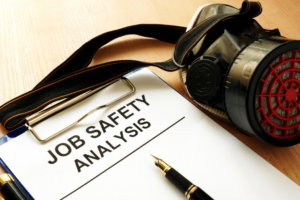June Safety Tip
Tips for Writing a Job Safety Analysis
A critical process in managing risk and reducing injuries in your workplace is writing a Job Safety Analysis. Some organizations have detailed and lengthy documents; others ask their workers to write a new Job Safety Analysis before they begin work every day.
What to include and how much information you need when writing a Job Safety Analysis is often difficult to determine. The answer depends on your company’s requirements; however, if your JSAs form part of your risk management documentation, they must reflect the way work is done and how it should be done.
For this article, we provide a six-step process for writing a Job Safety Analysis to guide you when managing high-risk tasks.
Decide Which Tasks Require a JSA
The determining factor when deciding to write a Job Safety Analysis for a process is the level of risk that is present while completing the tasks that need to be done. The first step is to prioritize the tasks and to focus on the highest risk ones first. Areas to consider are:
- Accident frequency and severity: The frequency or severity of past injuries can suggest where to begin writing a Job Safety Analysis.
- Newly established jobs or new machinery: New tasks may present more risk because your workers are not yet familiar with these jobs.
- Potential for severe injuries or illnesses: Jobs that involve hazardous materials or dangerous conditions may have more significant potential for a workplace injury.
- Infrequently performed jobs: Like new tasks, jobs that are performed occasionally may present a higher risk because workers don’t know which hazards to anticipate.
Break the Job into Specific Tasks
Once you’ve decided which job you want to write a JSA for, you need to list the steps that you need to take to complete the work. List from beginning to end, step, by step, similar to writing a recipe.
Try not to use convoluted language and be precise and clear. After all, a JSA is a step-by-step process that anyone should be able to follow to complete the task.
Breaking down a job into every single step will take time and effort, but it is critical for properly analyzing the overall risk associated with the job. It is also vital to ensure when writing a Job Safety Analysis that you involve your employees in the process to ensure that you capture everything and in the correct order. After all, they are the ones performing the work!
Determine the Hazards and Risks Present in Each Task
The next step is to identify any hazards that may be present as you complete the task. It would be best if you thought about the entire environment to determine any possible hazards that might exist while you perform the job.
From here, you need to assess the risk of injury each hazard presents. Using a risk matrix can help you to assess the probability and severity of the hazard to determine an overall risk rating. Check that you are using your employer’s Risk Ranking Matrix as it may differ from the one linked to in this document. You need to determine the level of risk that the hazard presents before you apply the control measures so that you have your Initial Risk Rating. Each step in the JSA should have an Initial Risk Rating applied.
How Do You Identify Workplace Hazards?
Unfortunately, identifying hazards doesn’t come naturally to all employees, and you can’t hide behind the notion that it’s just “common sense.” A hazard is defined as a task, application, tool, environmental condition, or otherwise that has the potential to cause harm – such as an angle grinder, mechanical power press, working at heights, loud noises, chemicals, etc. Employers can use various resources available to help train employees on hazard identification, including the Training Network or OSHA’s page on hazard identification and assessment:
https://www.osha.gov/safety-management/hazard-Identification
Identify Control Measures
The next step in writing a job safety analysis is to identify the controls measures that you practically can use to prevent the hazards from causing potential workplace injuries. Your guide here is to draw on the Hierarchy of Hazard Controls and use the highest level of control that is practicable to get the job done.
The Hierarchy of Hazard Controls is a risk management tool used around the world to manage workplace hazards. From the highest to the lowest level of controls, the hierarchy is as follows:
- Elimination – Physically remove the hazard
- Substitution – Replace the hazard
- Isolation – Isolate the hazard from people
- Engineering controls – Physical control measure, including a mechanical device or process
- Administrative controls – Change the way people work
- Personal protective equipment– Protect the worker with PPE.
It is not unusual to use a range of control measures for hazards. PPE should only be used as a last resort when all other measures are impractical or have been exhausted and the hazard remains.
Communicate Your Job Safety Analysis
It’s critical to circulate your Job Safety Analyses with your workers and other supervisors to ensure that you have covered all you need to make the job safe. You also need feedback about the control measures you select to determine if they are practicable and don’t create additional hazards.
Too often, JSAs are rarely seen as they gather dust on bookshelves or are forgotten as they are filed onto a computer hard drive. JSAs should be living documents that capture information about risks and inform your employees about both the hazards in their job tasks and the safest system of work. They should be reviewed often and updated as needed with any changes or additional improvements.
Maintaining a good JSA program is an ongoing and evolving process. If a workplace injury occurs, a review of the relevant JSA should occur to see if it had a shortcoming that may have contributed to the incident. Regular reviews offer insight into the hazards workers face with their jobs and tasks to produce effective risk management.
By facilitating communication, participation and engagement among everyone involved in your workplace, JSAs provide an opportunity to identify unforeseen hazards and increase support for a more robust, more inclusive safety culture.
Excerpted from: https://tapintosafety.com.au/tips-for-writing-a-job-safety-analysis/

